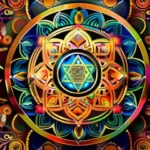Exploring the Unique Characteristics of Major World Religions
In this comprehensive guide, we delve into the unique characteristics that set popular religions apart from other belief systems. From ancient traditions to modern-day practices, we’ll explore six distinct chapters that shed light on what makes each religion special.
The Origins and Evolution of Major World Religions
The origins of major world religions are like intricate tapestries, woven from threads of time, culture, and human experience. Let’s delve into how these religions evolved over centuries, shaping societies and beliefs.
Imagine Christianity as a river that flowed out of Jerusalem. It began as a small stream, with Jesus Christ as the source, but rapidly expanded into a vast ocean, embracing diverse cultures through apostles like Paul who spread the gospel across the Roman Empire. How did this once-local movement transform into a global phenomenon? The answer lies in its ability to adapt and integrate into various social structures while maintaining core beliefs.
Moving on to Islam, it’s akin to a mountain that rose from the sands of Arabia. Founded by Muhammad, who received revelations from Allah through the angel Gabriel, this religion quickly gained followers as it combined elements of earlier Abrahamic traditions with its unique doctrines and practices. How did the Qur’an and Hadith shape the Islamic community’s identity? What role did the Five Pillars play in unifying Muslims across different lands?
Hinduism is like a vast forest, deeply rooted in the soil of ancient India, where countless deities and philosophies coexist in harmony. It evolved from Vedic rituals to the complexities of Bhakti movement, Advaita Vedanta, and many other schools of thought. How did the concept of dharma (duty/righteousness) guide Hindu society? What impact did various religious texts like the Bhagavad Gita have on spiritual practices?
Buddhism started as a path for enlightenment under the Bodhi tree, with Buddha seeking to end suffering. Over time, it spread across Asia through missionaries and texts like the Tipitaka. How did different schools of Buddhism (Theravada, Mahayana) diverge or merge, adapting to local customs while preserving core teachings? What role do monastic communities play in upholding Buddhist traditions?
Judaism is a storybook filled with historical events and commandments. From the covenant between God and Abraham to the formation of Israel under King David, this religion has been shaped by both divine promises and human struggles. How did religious texts like the Torah guide Jewish law and lifestyle? What impact do diaspora experiences have on modern Judaism?
Each of these religions offers a unique lens through which humanity views its existence. By tracing their origins and evolution, we can better understand not just their doctrines but also their profound influence on culture and society.
Core Beliefs and Practices
When delving into what makes popular religions distinct from other beliefs, it’s crucial to examine their core beliefs and practices. Imagine religion as a vast ocean, with each major world religion like a unique river flowing through different terrains—Christianity, Islam, Hinduism, Buddhism, Judaism—each with its own course, yet all interconnected by the vastness of humanity’s spiritual quest.
Consider Christianity, for instance; its sacred text, the Bible, is not just a book but a comprehensive guide to life. It tells tales of creation and salvation, encapsulated in the person of Jesus Christ. This central figure, often seen as the son of God, provides Christians with a moral code that emphasizes love, forgiveness, and charity. But how do these values compare to those found in other religions? Does Christianity’s emphasis on personal redemption through faith set it apart from the communal rituals and practices of Hinduism?
In contrast, Islam’s core beliefs revolve around the Quran, the holy book believed to be the word of Allah as revealed to the prophet Muhammad. The Quran guides Muslims in their daily lives with its teachings on faith, prayer, charity, and pilgrimage. But what about those who follow the path less traveled? How do these strict guidelines compare to the more philosophical approach found in Buddhism?
Hinduism, with its complex pantheon of deities and endless scriptures like the Rig Veda, offers a rich tapestry of beliefs and practices. The concept of reincarnation and the pursuit of moksha (liberation) stands out as a unique feature, emphasizing personal spiritual growth rather than a singular path to salvation. But what about those who look for more structured guidance? How does this compare to Judaism’s emphasis on adherence to the commandments and the covenant between God and the people?
Buddhism, with its core teachings from the Dhammapada, focuses on the Four Noble Truths and the Eightfold Path. It emphasizes inner peace and enlightenment through meditation and mindfulness. But in a world that often seems chaotic, how does this practice differ from the communal prayers found in other religions?
Each religion offers its own lens through which to view life’s challenges and questions. Whether it’s the Christian search for personal salvation, the Islamic path of submission, the Hindu journey towards moksha, or the Buddhist quest for enlightenment, these core beliefs and practices provide a framework that shapes not only individual lives but also the fabric of societies.
The Role of Religion in Society
How do popular religions distinguish themselves from other beliefs, and what role have they played in shaping societies? Let’s delve into this question by considering how these faiths have intertwined with politics, culture, and daily life.
Imagine religion as a river, flowing through the landscape of human history. Some rivers are broad and deep, like Hinduism, carving out vast landscapes and influencing every aspect of society from birth rituals to political structures. How did this ancient river shape Indian civilization? The caste system, for instance, is rooted in Hindu scriptures, dictating social roles and relationships even today.
Now, picture another river, smaller but no less profound: Buddhism. This stream flowed through the lands of what is now Southeast Asia, bringing not only spiritual guidance but also a philosophical approach to governance. The idea of non-violence (ahimsa) and mindfulness has permeated political thought in countries like Thailand and Sri Lanka, influencing how conflicts are resolved and peace maintained.
Consider the impact on daily life too. In Muslim-majority societies, such as those in the Middle East or Southeast Asia, religious observances like prayer times profoundly influence work schedules and social norms. The call to prayer (adhan) is more than a spiritual reminder; it marks the rhythm of the day, echoing through streets and shaping communal life.
And what about Judaism? Here, religion is woven into the very fabric of national identity in Israel, where religious laws influence everything from education to health services. The interplay between religious practices and state policies raises complex questions about the balance between tradition and modernity.
Through these examples, we see that popular religions are not just personal beliefs but powerful forces that shape societies, influencing politics, culture, and daily routines. Each religion brings its unique river to the landscape of human experience, creating a rich tapestry of shared values and practices.
Religious Art, Architecture, and Symbolism
Religious art, architecture, and symbolism are like the visual DNA of each faith, painting vivid pictures of their beliefs and values. Have you ever gazed upon the towering spires of a Gothic cathedral, wondering about the spiritual journey it represents? Or perhaps you’ve wandered through a serene Buddhist temple, feeling the calm and tranquility that pervades every corner? These architectural marvels are more than just buildings; they are living testaments to the profound impact of religious practices on human culture.
Take the intricate mandalas of Tibetan Buddhism. These spiritual and ritual symbols are often seen as representations of the universe, embodying a complex system of Buddhist cosmology. Each line, each color holds deep meaning, guiding both the creator and the viewer through layers of symbolism. Mandalas are like maps to enlightenment, leading one towards inner peace and understanding.
Then there’s the iconic Christian cross, an enduring symbol of sacrifice and redemption. From the simple wooden crosses in rural churches to the ornate ones adorning cathedrals, this symbol has become a global identifier of faith. It serves as both a reminder and a source of strength for believers, often seen hanging on walls or worn as jewelry.
Similarly, Hindu temples are adorned with intricate carvings depicting scenes from sacred texts like the Ramayana and Mahabharata. These stories come to life through stone and marble, telling tales that have been passed down for centuries. The sheer detail in these carvings is awe-inspiring, each figure a miniature universe filled with meaning.
And let’s not forget the Islamic minarets that pierce the sky at dawn and sunset. These iconic structures are not only functional but also a form of communication, calling the faithful to prayer five times a day. Their presence in the urban landscape is both a reminder of faith and an architectural marvel, blending beauty with functionality.
Each of these elements—art, architecture, and symbolism—plays a crucial role in shaping the identity of a religion. They are the visual narratives that speak to the soul, making the intangible aspects of faith tangible and relatable. Whether it’s the spiritual journey represented by cathedrals or the intricate details of mandalas, these artistic expressions are what make popular religions distinct from other beliefs, weaving together threads of tradition, culture, and devotion into a rich tapestry of human experience.
Religious Festivals and Celebrations
Imagine walking into a bustling temple during one of its most vibrant festivals, where the air is thick with incense and the sounds of drums and chanting fill your ears. You can’t help but wonder: What makes these celebrations so distinct from those in other religions? How do they reflect the unique beliefs and practices of each faith?
Consider the Holi, a colorful Hindu festival that celebrates the triumph of good over evil. During this time, devotees throw colored powder and water at one another, symbolizing the breaking down of barriers and the joy of unity. This ritual is not just about fun and games; it’s a profound reminder of the importance of inclusivity and the celebration of diversity within Hinduism.
Then there’s Carnival, which finds its roots in Catholic communities, particularly before Lenten fasting begins. The festival is a wild mix of parades, music, and dance that serves as an elaborate farewell to indulgence. It’s almost like a metaphor for the cycle of life—embracing joy and excess before reflecting on personal growth.
In contrast, the Festival of Lights in Judaism, or Hanukkah, is a more subdued affair marked by the lighting of candles and the sharing of stories. This festival commemorates the miracle of oil that lasted eight days, symbolizing resilience and hope against oppression. The intimate nature of the celebration reflects the Jewish value of family and community.
Each religious festival is like a window into the heart of its faith, revealing its core values through vibrant traditions. They are more than just social events; they are living expressions of spiritual journeys and collective identities. So, as you watch the world come alive with religious celebrations, pause to consider: What stories do these festivals tell about their communities? And how do they enrich our understanding of different belief systems?
Modern Trends and Controversies in Religion
Have you ever wondered why some religions dominate the world stage, influencing millions? Is it their ancient texts or the charisma of their leaders that makes them stand out? Or could it be something more subtle – like how they adapt to modern times and technology?
Take a moment to ponder: What if religion were like a plant, growing in different climates and soil? Some thrive in urban settings, while others flourish in rural landscapes. The same can be said for religions; their distinct characteristics are shaped by the socio-political environment they encounter.
- One could argue that popular religions have strong foundational narratives that resonate with people’s need for meaning and purpose. Think of Christianity, Islam, and Hinduism – all offer rich stories that address fundamental questions about life, death, and the divine.
But it’s not just their ancient wisdom that sets them apart. The way they navigate modern challenges also plays a significant role. How do they reconcile with scientific advancements? For instance, how has the theory of evolution affected the interpretation of creation stories in these religions?
- The role of technology is another pivotal factor. Many popular religions are embracing digital platforms to spread their message and engage younger generations. But this shift raises questions: Is religion losing its authenticity when it goes online? Or does it become more accessible and inclusive?
Lastly, the impact of secularization is a complex issue. As societies become more secular, religions must adapt or risk losing relevance. Do they push back against modern values, or do they find common ground with them? The tension between tradition and progress defines much of today’s religious discourse.
So, the next time you witness a grand religious festival, remember that beneath the colorful celebrations lie deep-seated beliefs and contemporary challenges. These religions are not just ancient traditions but living entities, evolving to meet the needs of their followers in an ever-changing world.
Conclusion
 By understanding these key differences, you’ll gain a deeper appreciation for the rich tapestry of religious beliefs that shape our world today.
By understanding these key differences, you’ll gain a deeper appreciation for the rich tapestry of religious beliefs that shape our world today.











